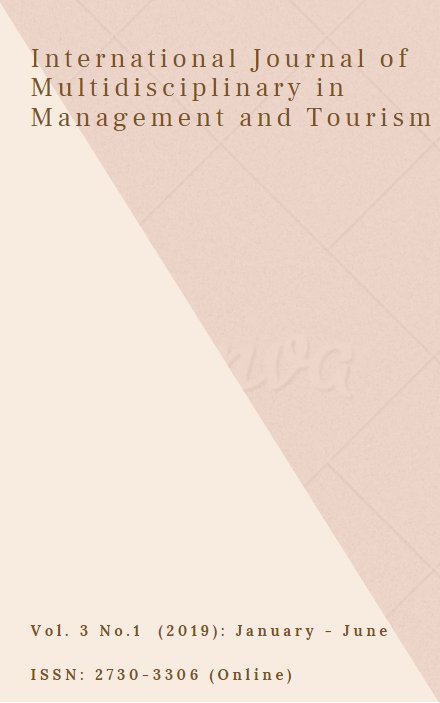The Determinate Factors to Wildlife Consumption of People in Urban Areas in Lao PDR
Main Article Content
Abstract
The study of the determinate factors to wildlife consumption of people in urban areas in Vientiane capital, Bolikhamsay, Khammouane, Savannakhet and Champasak. The results of the study found that most people consume wildlife. The wildlife consumption will include consumption by consumers who do not buy themselves and consumers as buyers themselves. But consumer consumption by the buyer itself is more than that, indicating that Lao people's wildlife consumption is not consumed, for survival but for consumption in the form of Felicity. In addition, consumption is mainly during the period of wildlife (during the rainy season) where the consumption of wildlife of the population does not take into account the effects. But it is thought to be delicious meat and is consumed without respect for the laws. But not only the people who do not respect the laws of the state---the state also has state officials who are the core of the Lao people, which has not yet complied with the laws set out in the self-styled, rule-makers, and forced to use in the area. However, there is still a significant proportion of the population involved in the protection of wildlife, respect for wildlife regulations that the government has set up without hunting and wildlife trade, which is a threat to the population of wildlife. The factors that determine the consumption of wildlife of the population are as follow gender, education, occupation, belief, and law affects the consumption of wildlife of the population, but the factors of faith and legal factors are more influential than other factors. Among these factors are only legal factors that are negative or contradictory to wildlife consumption, while other factors contribute to the consumption of wildlife of the population.
Article Details
References
Brashares, J. S., Golden, C. D., Weinbaum, K. Z., Barrett, C. B., &Okello, G. V. (2011). Economic and geographic drivers of wildlife consumption in rural Africa. Proceedings of the National Academy of Sciences, 108(34), 13931-13936.
Chardonnet, P., Clers, B. D., Fischer, J., Gerhold, R., Jori, F., &Lamarque, F. (2002).The value of wildlife. Revue scientifiqueet technique-Office international des épizooties, 21(1), 15-52.
Department of Environmental Quality, Ministry of Science, Technology and Environment of Thailand. Source https://web.ku.ac.th/schoolnet/snet6/envi2/subtiger/ subt.htm (October 20, 2017)
Drury, R. (2011). Hungry for success: urban consumer demand for wild animal products in Vietnam. Conservation and Society, 9(3), 247.
Duckworth, J. W., Salter, R. E. and Khounboline, K. (1999). World Conservation Union: KhounbolineWildlife in Lao PDR. 1999 status report.
Godoy, R., Undurraga, E. A., Wilkie, D., Reyes‐García, V., Huanca, T., Leonard, W. R., &Vadez, V. (2010). The effect of wealth and real income on wildlife consumption among native Amazonians in Bolivia: estimates of annual trends with longitudinal household data (2002–2006). Animal Conservation, 13(3), 265-274.
Greene, W. H. (1995). Limdep Version 7.0 User Menu. New York: Econometric Software Inc.
Jnawali, S. R., Baral, H. S., Lee, S., Acharya, K. P., Upadhyay, G. P., Pandey, M., ...&Khatiwada, A. P. (2011). The Status of Nepal Mammals: The National Red List Series, Department of National Parks and Wildlife Conservation Kathmandu, Nepal. Preface by Simon M. Stuart Chair IUCN Species Survival Commission The Status of Nepal’s Mammals: The National Red List Series, 4.
Hicks, J. (1939). Value and Capital: An Inquiry Into Some Fundamental Principles of Economic Theory.[MitSchaubildern und EinemMathematischenAnhang]. Clarendon Press.
Hosmer, D. W., Taber, S., &Lemeshow, S. (1991). The importance of assessing the fit of logistic regression models: a case study. American journal of public health, 81(12), 1630-1635.
Keynes, John M. (1936). The General Theory of Employment, Interest and Money. New York
Kotler, P. (1972). Marketing decision making: A model building approach.
Kyophilavong, P., Sysouphanthong, V., Bounyalasy, M., &Phonevisay, A. (2015). Using STATA for Economics, Faculty of Business and Business Administration, National University, State Library.
Lindsey, P. A., Frank, L. G., Alexander, R., Mathieson, A., &Romanach, S. S. (2007). Trophy hunting and conservation in Africa: problems and one potential solution. Conservation biology, 21(3), 880-883.
Macdonald, D., &Loveridge, A. (Eds.). (2010). The biology and conservation of wild felids (Vol. 2). Oxford University Press.
Ministry of Natural Resources and Environment. (2016). Increasing the focus on implementation of livestock and wildlife management practices across the country, Vientiane.
National Assembly. (2008). Law on Wildlife and Wildlife, Vientiane Capital.
Prime Minister's Office. (2009). Resolution of the Prime Minister on the approval of the List of Listed Wildlife and Wild Fauna or Accounts I and Type II, Vientiane Capital.
Rao, M., Myint, T., Zaw, T., &Htun, S. (2005).Hunting patterns in tropical forests adjoining the Hkakaborazi National Park, north Myanmar. Oryx, 39(3), 292-300.
Shairp, R., Veríssimo, D., Fraser, I., Challender, D., & MacMillan, D. (2016). Understanding urban demand for wild meat in Vietnam: Implications for conservation actions. PloS one, 11(1), e0134787.
Suwannarong, K., Chapman, R. S., Lantican, C., Michaelides, T., &Zimicki, S. (2015). Hunting, Food Preparation, and Consumption of Rodents in Lao PDR. PloS one, 10(7), e0133150.
Toummanisone, T. (2017). Assessing the Satisfaction of the Capital in Khammouane Province for the Conservation of Neighboring Protected Areas: Using the Assumption Method, Faculty of Economics, Economics and Business Administration, National University.
Van Song, N. (2008). Wildlife trading in Vietnam: situation, causes, and solutions. The Journal of Environment & Development, 17(2), 145-165.
Wildlife Conservation Society of Lao PDR. (2010). The link between wildlife management and household consumption in the highlands of Lao PDR, Vientiane.
Wyler, L. S., & Sheikh, P. A. (2008, August). International illegal trade in wildlife: Threats and US policy. Library of Congress Washington DC Congressional Research Service.
Zhang, L., Hua, N., & Sun, S. (2008). Wildlife trade, consumption and conservation awareness in southwest China. Biodiversity and Conservation, 17(6), 1493-1516.
Zhang, L., & Yin, F. (2014). Wildlife consumption and conservation awareness in China: a long way to go. Biodiversity and conservation, 23(9), 2371-2381.

